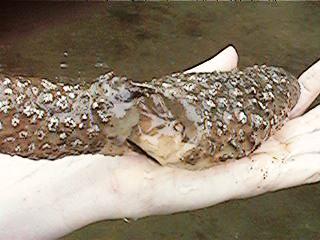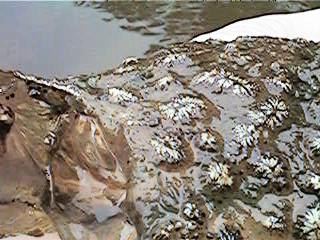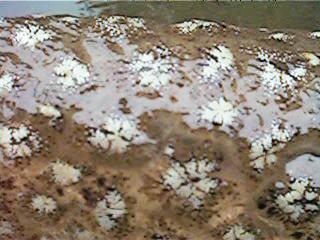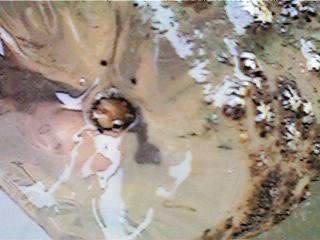 This
is the Pectinatella magnifica specimen which you were viewing. The
following pictures are close-ups of its surface and internal jelly, taken
just to the right of its break.
This
is the Pectinatella magnifica specimen which you were viewing. The
following pictures are close-ups of its surface and internal jelly, taken
just to the right of its break. This
is the Pectinatella magnifica specimen which you were viewing. The
following pictures are close-ups of its surface and internal jelly, taken
just to the right of its break.
This
is the Pectinatella magnifica specimen which you were viewing. The
following pictures are close-ups of its surface and internal jelly, taken
just to the right of its break.
 P.
magnifica has a clear, golden-tan jelly which is covered by the actual
colony. Each of the small clusters in this close-up contains hundreds of
the individual-animal lophophores.
P.
magnifica has a clear, golden-tan jelly which is covered by the actual
colony. Each of the small clusters in this close-up contains hundreds of
the individual-animal lophophores.
 Even
this closer view doesn't show the individual lophophores.
Even
this closer view doesn't show the individual lophophores.
 This
view shows a little of that outer crust, but focusses on the internal jelly.
The central detail is the broken end of its once-supporting twig. The jelly
harbors a type of non-biting midge larvae, and appears to be a favored
food for raccoons. (For technical information on the composition of this jelly, see 29 Sep 1997 message from Byron Backus.)
This
view shows a little of that outer crust, but focusses on the internal jelly.
The central detail is the broken end of its once-supporting twig. The jelly
harbors a type of non-biting midge larvae, and appears to be a favored
food for raccoons. (For technical information on the composition of this jelly, see 29 Sep 1997 message from Byron Backus.)